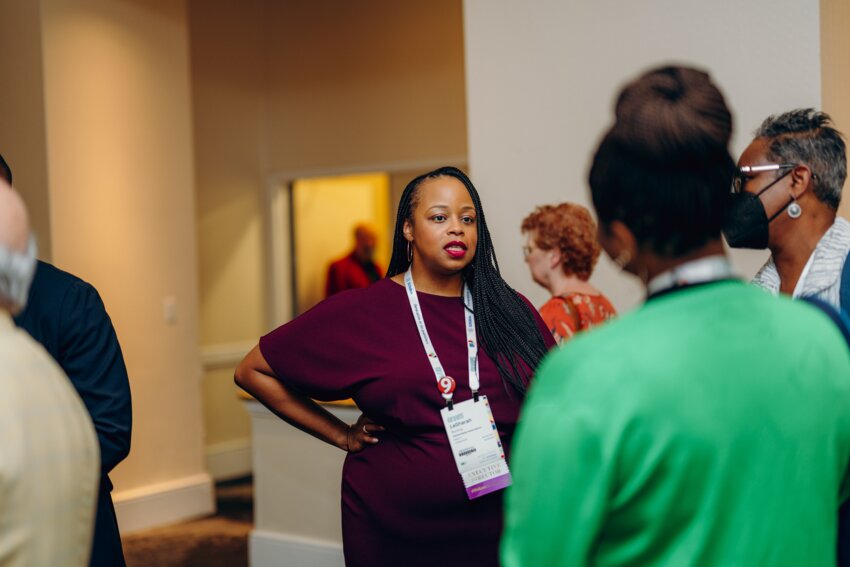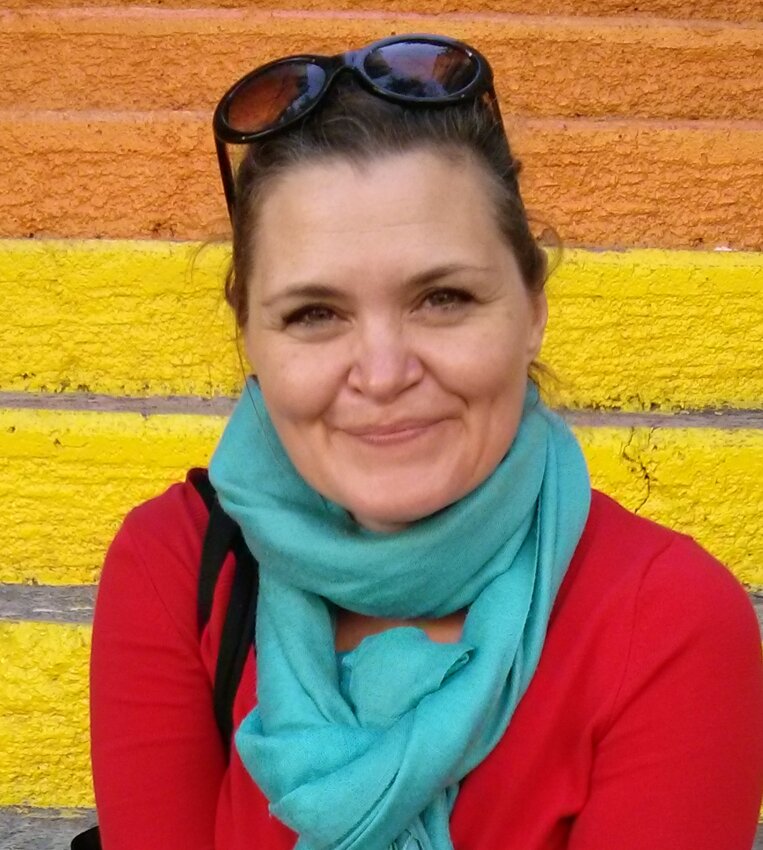
It's a tumultuous time in journalism. Outlets are shuttering, and layoffs seem constant. The recent layoffs at the Los Angeles Times provoked concerns across the industry as more than 50% of those cut were journalists of color.
How do we turn the tide and not lose the gains already realized? Can technology help? What’s a good business model in this new media era?
These questions are at the forefront of the minds of Ashanti Blaize-Hopkins, president of the Society of Professional Journalists (SPJ); LaSharah Bunting, CEO and executive director of the Online News Association (ONA); and Karen Rundlet, CEO and executive director of the Institute for Nonprofit News (INN).
Over the past year, each has stepped into the lead role at three of the most influential news associations, each as the first Black woman to hold the post. In interviews with E&P, they spoke about their new roles, how they got there and how they hope to advance their individual organizations and journalism writ large.

With over 75 years of news industry experience between them, each launched careers as digital and multimedia took hold of the industry.
“I became an early digital evangelist in the newsroom,” said Bunting, as she described her early career at The New York Times and recounted being named the senior editor for their digital transition in 2014. "Our team was tasked with how to move The New York Times from this print-focused 100-plus-year-old institution to a digital-first institution. [It] has yielded amazing results when you look at the subscriber numbers and the amazing journalism that's come out of it," said Bunting.
Bunting said she joined ONA as a member and attended her first conference in 2012 at the invitation of her Times colleague, Jennifer Preston, who told her she’d find a kindred internet-savvy community in the association. Bunting said mentorship, like Preston's, has been something she's benefited from and is essential to her. She recently wrote about an early mentor, Dick Thien, for her alumni magazine, The Nebraska Quarterly, and she holds regular slots on her calendar for young journalists to have one-on-one sessions.
Karen Rundlet started her career in local broadcast news and public radio before she landed at her hometown paper, the Miami Herald, in 2005. She helped build the paper's video unit and created multimedia productions for Pulitzer-winning investigations. She also helped define their strategy for reaching audiences on social media.
"My mother was a religious reader of the Miami Herald,” Rundlet said. She explained she was born in Jamaica, and her family moved to Miami when she was young. “She would hold up the newspaper and say, ‘This is how we're going to understand the system.’ I always understood journalism as a place of learning that could help my life and help the community.”

Bunting and Rundlet eventually worked together at the John S. and James L. Knight Foundation in Miami, an organization that, as Rundlet explained, was known to her through her reporting in the community for supporting the arts and research. Both worked at the foundation, helping to determine which news efforts might get Knight's support.
Rundlet said they focused on innovating journalism while supporting new business and tech models, and they did scenario planning. “I’m a big believer in not just thinking about what you’re going to do in the future, but to look around and see how the world is shifting and rehearse for the world that's coming, and deeply understand how communities and people are interacting with information and news,” she said.

Blaize-Hopkins started at the South Florida Sun Sentinel in the broadcasting department before moving to Texas and becoming an Emmy-winning local television dean at the Center for Media and Design at Santa Monica College in California while serving as SPJ's president.
She said SPJ was only on her radar as a young journalist once someone from the local chapter in Los Angeles approached her to take an interim seat on their board.
"Honestly, I didn't consider it. It didn't seem like a place for me. I never saw anyone there who looked like me. But they listened when I agreed to be on the board and brought up the lack of diversity in the organization and leadership. And some people stepped down into associate positions on the board to make room for diverse leaders. That meant a lot."
Blaize-Hopkins recalled that Rebecca Aguilar, a reporter she met while working in Dallas a decade ago, encouraged her to go for the presidency of SPJ’s national board. Aguilar was the first Latina to serve as the organization’s president. "She saw something in me. Being a first, she did not want to slam the door on women of color, or people of color in general, to that leadership role. She wanted to prop the door open," Blaize-Hopkins said.
Aiming for next-stage growth during lean times

Since taking the helm at ONA in March of 2023, Bunting and her team have reviewed all aspects of the organization, including its programs, to align with industry shifts and innovations. The organization has over 2,100 members and an operating budget of $3 million, focusing on digital journalism.
In mid-March, ONA made headlines with some cost-saving reductions, canceling programs, including their Student Newsroom and Innovation Lab. Nieman Lab quoted Bunting as saying, “[We] will be diligent about our sustainability, even when it involves difficult decisions like this.”
Since Bunting took over, the organization has also added and changed a few other programs. They decreased the attendance fee for their annual conference to make it more affordable for members from smaller organizations and launched an "AI in Journalism" initiative to provide training and create a lab for innovation and collaboration. Bunting said they are also committed to continuing their Women's Leadership Accelerator program and their fellowship program for young journalists from HBCUs.

Rundlet stepped into her new role at INN in January, replacing Sue Cross, who led the organization since 2015 and helped quadruple its membership to a membership of 425 independent nonprofit newsrooms, including City Bureau, CalMatters and ProPublica. The organization manages the annual fundraising effort Newsmatch and provides member education and business support services.
Rundlet says she’s in the midst of an initial learning period and will be looking at all aspects of the work it does. In addition to talking to INN’s staff and board, she’s also talking with member organizations one-on-one to get a sense of their needs and thoughts on how INN can better serve them. "I want us to be an organization people talk to, not just who they talk about,” she said.
In her interview with E&P, Rundlet committed to continuing the INN Index, an annual survey of its membership newsrooms that's become an industry indicator of the issues and challenges facing newsrooms. It includes the Index DEI Report, which documents nonprofit newsrooms' efforts to diversify their staff, leadership and coverage.

Looking to the future, Rundlet said she thinks it is critical to help newsrooms figure out viable business models and to look at how they are serving audiences. “We can’t just do great journalism that nobody consumes, reads, listens to or views. We have to really deliver a product that is valuable to local residents — to national residents. It has to be, 'If I read this, if I watch this, I walk into the world better prepared to manage my life, to connect with my neighbors, to function in this world,'" said Rundlet.
While Bunting and Rundlet walked into financially stable organizations, Blaize-Hopkins assumed the presidency of SPJ in December as the organization clocked its third year in the red, ending 2023 with a $247,000 shortfall.
Blaize-Hopkins and SPJ leadership had to make some tough choices to right the organization. This included not holding an annual convention in 2024.
“Is everybody happy that we’re not having a convention in 2024? No. But if it’s a decision between ensuring the sustainability of our organization or just having a one-off convention that may or may not make money, I’m going to choose the sustainability of our organization every single time,” said Blaize-Hopkins.
With their decisions so far, they are on track to end this year with a $220,000 surplus. Blaize-Hopkins said this will better position them to hold a 2025 convention in partnership with the College Media Association and the Associated Collegiate Press.
Given everything, there's a thorough review of the century-old organization, its programs and its mission. "The ways we have done things in the past may not necessarily work going forward because we are just in a very different environment," Blaize-Hopkins explained. "And we have to evolve, or we die. At the end of the day, my job is to ensure that this organization will be around past my tenure as president."
Among her ideas is narrowing the organization's focus and positioning SPJ as a champion for ethical journalism, fronting its Code of Ethics and defending journalism from growing attacks. She also sees a role for the organization in engaging the larger public directly, in a way the organization has never done, to combat misinformation and to help audiences better understand how journalists do their work.
All three women spoke about how journalism is a form of service for them, a way to serve the community and democracy, and they each see the work they’ve set out to do as a way to fortify the industry and democracy.
Blaize-Hopkins put it this way: “I have this thing that I often say that I don’t take on any opportunities unless I feel like I can be impactful. I say that because I always have my ancestors speaking in the back of my head and understanding how much work they had to do just to be seen as human — just the bare, minimal human. And so, for me, it’s my mission in life to take these opportunities that I’m given to make this one life that I have been given impactful. And so, for me, my ancestors laid the groundwork for bringing people along. Right? Stepping into spaces, ushering someone else in, giving them some of the opportunities you were given. I feel like it is something that is just in me to ensure that, even if I'm the first, I’m definitely not going to be the last.”
 Diane Sylvester is an award-winning 30-year multimedia news veteran. She works as a reporter, editor, and newsroom strategist. She can be reached at diane.povcreative@gmail.com
Diane Sylvester is an award-winning 30-year multimedia news veteran. She works as a reporter, editor, and newsroom strategist. She can be reached at diane.povcreative@gmail.com
Comments
No comments on this item Please log in to comment by clicking here